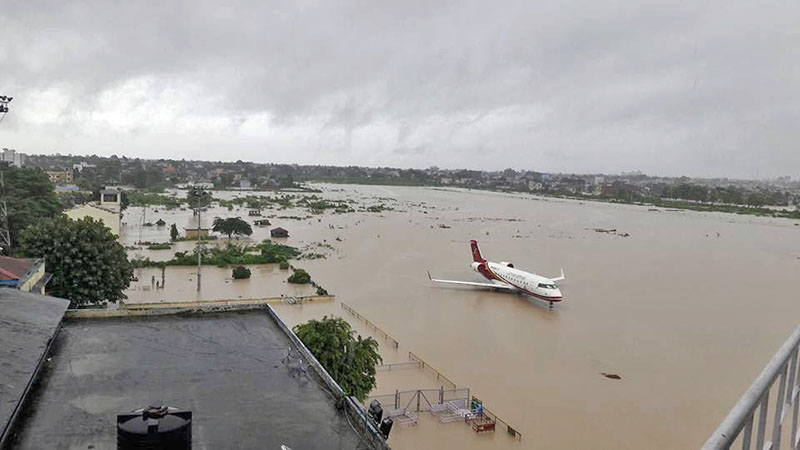Disaster response plans fall flat at flood-hit Biratnagar airport
KATHMANDU: An airport, naturally, assumes the significance of a hub for helping in any disaster relief operations and that is why a country invests heavily into it, including significance donor assistance, whether it is disaster response plans or the UNDP-funded get airports ready for disaster project.
Here the country’s second largest airport in Biratnagar is the airport that needs help.
According to stakeholders, the sustained incapacitation of Biratnagar airport, arising out of the recent floods, has once again revealed that nation’s civil aviation indeed remains fragile, especially when the airport was recently certified as meeting international standards with a purportedly convincing emergency plan.
It is unlikely that the airport will resume normal instrument as well as night-time operations before months, even when the flood deposits have been cleared, officials have also admitted.
Talking to THT, Biratnagar airport chief Suresh Man Shrestha told that there was uncertainty about resuming operation.
Besides, road transportation was badly hit by floods and landslides, air passengers have also been facing serious problems after over a dozen daily flights from Biratnagar were cancelled.
Interestingly, the US- assistance made Tribhuvan International Airport Disaster Response Plan itself was nothing short of a disaster, shortcomings of which were thoroughly exposed in the aftermath of the 2015 earthquakes, when the response was characterised by utter chaos despite the airport infrastructure remaining mercifully left intact, a TIA officer recounted.
“The Nepali personnel trained at the US Pacific Disaster Center, Honolulu are nowhere to be seen at TIA, perhaps having left for greener pastures.”
Two years on, it’s now the Biratnagar airport fiasco, occurring barely six months after the latest UNDP-funded GARD, which paints a dismal picture of the thorough incompetence of professionals and leadership at the Civil Aviation Authority of Nepal despite possessing workshop completion certificates, a senior manager at a private airlines commented.
According to him, the weird mechanism at CAAN utterly exposed in Biratnagar as no technical personnel were available to power-off or elevate critical airfield lighting system components as flood waters gradually rose and submerged them.
“It will be months before the critical visual aids for landing- precision approach path indicators- are even made operational after specialised light check aircraft for resuming night operations.”
Hub airports, including Biratnagar, are manned by eleventh level CAAN directors and former tower controllers, who preside over airport and tower personnel of ranks two levels below but none of the hub airports have positions to accommodate experienced engineers – electrical, civil and radio, as it is remotely supported from Kathmandu head quarters, ostensibly for optimising technical manpower, a CAAN director admitted.
It is unlikely that any one will be held accountable for lapses in engineering related design issues, he reacted, adding that these significant losses and the inconvenience to public as Dasain and Tihar festivals draw nearer are certainly an ode to the culture of incompetence and mediocrity prevailing in CAAN.
According to the airline operators, Biratnagar sees a significant surge in night flights during the festival season.






